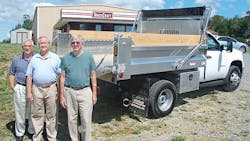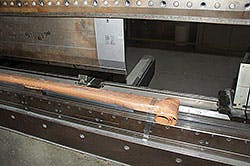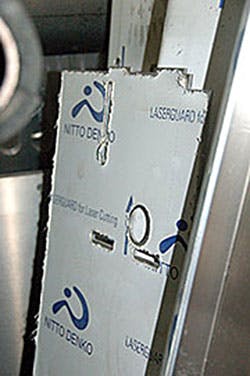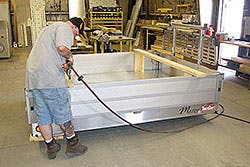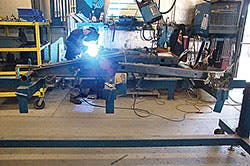TruckCraft carves out niche with specialty truck bodies
TRUCK body manufacturers do not have to be big to be productive.
TruckCraft Corporation is a case in point. The Chambersburg, Pennsylvania, company knows how to get the most out of its 15,000-sq-ft facility.
“Most people who visit us for the first time remark how they thought our plant would be bigger than it is,” President Gary Shoup says with a smile. “Business has been great, and we may be forced to expand, but our philosophy is to concentrate on what we do best.”
TruckCraft is more of a designer and assembler of specialty truck bodies. The company’s product line is broad: it includes service bodies, dumps, flatbeds, and spreaders. Yet the plant is compact because TruckCraft turns to third parties for pieces and components that require lasers and other sophisticated machine tools to produce.
The TruckCraft approach does not require multiple production lines or anything more than a few basic machine tools. Rather, the company relies heavily on its aluminum and steel suppliers to provide laser-cut pieces that can be easily assembled with minimum waste.
Truck bodies are made of individual pieces that use a system of slots and tabs that index themselves for ease of assembly. The company’s aluminum warehouse delivers the blanks, each of which has been cut by laser for pinpoint accuracy. They are then placed in shop-built fixtures, most of which are designed and built by Jerry Pool, a co-owner. As a niche manufacturer, TruckCraft designed and built several fixtures that are versatile enough to accommodate a wide range of product offerings.
This approach enables TruckCraft to concentrate on design and assembly of truck bodies, primarily truck bodies made with aluminum extrusions and sheet. But it also requires close cooperation so that the aluminum supplier cuts each part in such a way that bends that TruckCraft makes with a press brake are perpendicular to the grain of the aluminum.
Examples of other services provided by third-parties include powder coating and the electronic controls used on the TruckCraft line of salt spreaders. Engineering and assembly remain TruckCraft specialties.
Do it yourself
Others may provide fabrication services, but what the component pieces are and how they go together are among what TruckCraft “does best.”
“We designed all the dies that we use,” Shoup says. “An extruder provides the 6061 T6 extrusions that we need.”
Like most other manufacturers, the company also designs and builds the fixtures. Because of the variety of truck bodies that the company manufactures, flexibility is a virtue.
“Whenever it looks like the products we are introducing are too big for those fixtures, we will figure out a way to make things work, either by modifying existing fixtures or building new ones.”
Outgrowing fixtures is not a rare occurrence at TruckCraft. The company initially catered to light-duty trucks. Bodies now are offered for medium-duty chassis such as the Ford F-550.
TruckCraft now offers eight classes of products, most of which are made of aluminum. Its line of truck bodies include aluminum service bodies, flatbeds, flatbed dumps, one-ton dumps, pickup dump inserts, combination dump and service bodies, and spreaders. The company also produces a storage unit called the Space-Pak which spans the width of the chassis from the frame rails to the top of the cab. Mounted immediately behind the cab, the Space-Pak provides up to 56 cubic feet of secured storage. The company also produces its own line of truck hoists.
Drawings, not sketches
TruckCraft offers a variety of standard options, but the company can get a little finicky when it comes to the way new changes are drawn up.
It’s not uncommon for an idea in the truck body industry to start out sketched out on the back of a napkin or on the plant floor, but the idea does not stay that way at TruckCraft.
“We operate off drawings, not sketches,” says Roy O’Neal, sales manager. “We never make any modifications without making a CAD drawing and running it though our system.”
TruckCraft’s first venture into computer-aided design years ago produced two dimensional drawings. Today’s engineering package produces three-dimensional solid modeling and includes finite element analysis.
“We put a lot into our designs,” O’Neal says. “And through the use of finite element analysis, we can increase the strength of our products without increasing weight. Overall, it enables us to build a better product.”
Why aluminum
The TruckCraft product line is predominantly aluminum, despite the fact that the company got its start in 1992 manufacturing steel dump inserts for pickups and combination dump and service bodies.
“We love the attributes of aluminum,” Shoup says. “Weight savings, fuel savings, the fact that it can be recycled, corrosion resistance. All of these are important to customers these days. Over the years, we have gained plenty of experience working with aluminum. Like a lot of manufacturers, we have learned what works and what doesn’t. It’s things that any veteran manufacturer has come to know with experience—like the type of alloy that works best in a particular application, how much of a bend radius specific alloys can take, getting the sheet oriented properly on the press brake so that it doesn’t crack. Aluminum is a metal we have grown to appreciate and have learned to work with.”
TruckCraft recently came up with a new option for its aluminum flatbed bodies—the Traction Plank. The option is a grooved extrusion that provides a rough, slip-resistant surface for walking. The company introduced it in response to dealer requests.
“A rough extruded surface offers better traction than treadplate,” Shoup says. “and it is easy for us to integrate into our existing designs.”
Evolutionary innovation
Starting in 1992 with two lines of steel products, TruckCraft now offers eight classes of products, made primarily of aluminum.
“It’s been an evolutionary process,” Shoup says. “Everything we offer has been an incremental step based on something we already were doing. We made aluminum versions of steel products. If we offered an aluminum insert dump that had an extrusion, we realized we could use that same extrusion to make a flatbed. After we came out with the aluminum flatbed, customers told us they needed an aluminum dump body.
“From beginning, emphasis has been on engineering, even during the recession. We introduced our Zeus dump body during the recession. The Storm landscaper body came out then also, as did our small dump platform.”
The company also has begun to use structural adhesives instead of welding for certain products, especially on its Space-Pak storage compartments.
“Bonding can be a good option for products that have long, unsupported stretches of aluminum,” Shoup says. “Welding aluminum in these situations can produce an oilcan effect because of heat expansion. Painting makes it less obvious, but by using adhesives instead of welding, you never have the problem in the first place.”
Dealing with dealers
TruckCraft sells its products through a network of 135 dealers who operate 160 locations in the U S and Canada.
“We have a lot of dealers because we manufacture niche products,” O’Neal says. “But even though we manufacture niche products, we design them so that the dealer can install them with common hand tools.”
The company only sells its products through dealers.
“When we first went into business, we sold to anyone we could,” O’Neal says. “But it didn’t take long to find out the problems that causes.” ♦
__________________
Click here to view all large photos and captions
for TruckCraft specialty truck bodies
About the Author
Bruce Sauer
Editor
Bruce Sauer has been writing about the truck trailer, truck body and truck equipment industries since joining Trailer/Body Builders as an associate editor in 1974. During his career at Trailer/Body Builders, he has served as the magazine's managing editor and executive editor before being named editor of the magazine in 1999. He holds a Bachelor of Journalism degree from the University of Texas at Austin.
